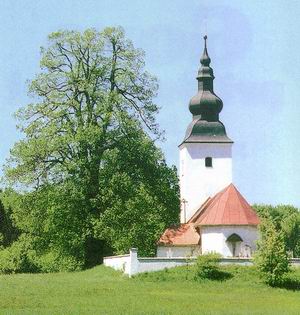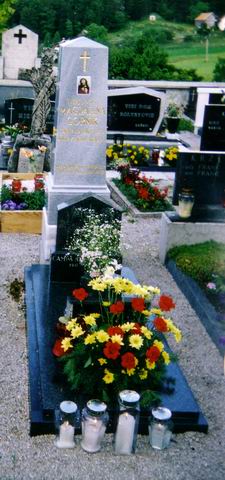Biography

19 July 1835: In Gora near Sodražica, precisely in the village of Janeži, house number 4, Magdalena was born of poor parents, Ana and Joseph Gornik, and the third of seven children. She was baptized the same day in the local church Maria of the Snows in Gora.
1835 1846: Magdalena was a completely normal child. She helped her parents with farm work and enjoyed the company of her peers. She was friendly and affectionate to others. She used most of her free time for prayer and developed a special love for Jesus in the Blessed Sacrament.
Spring 1847 In a field Magdalena experienced her first meeting with the Heavenly Lady. She appeared to Magdalena as a peasant woman and asked her to whom she offered her work and if she loved Jesus. Magdalena answered that she offered her work to Jesus and that Jesus knows best if she loves Him. She did not recognize the woman. After that the woman presented herself as the Mother of Jesus and of all people ; she indicated that her intention in the future was to teach Magdalena the reasons for work, to whom to offer her work, and that Magdalena must still love her Son, Jesus, more strongly. She taught Magdalena that she should thank God for all of His kindness and offer all of her work to Him. This vision touched Magdalena's heart very deeply, and thus she prayed even more and attentively prepared for her First Holy Communion.
1847 Magdalena received her First Holy Communion. At that moment God burned such zealous love in her heart that her physical strength drained from her, and she could hardly return to her place from the Communion rail. When she knelt to give thanks, she heard a voice from the altar: Tell no one what happened to you. She was convinced that other girls also heard the voice. No, she heard further: They do not hear this voice, only you. I am the one whom you have just received. Magdalena did not tell this to anyone. Alone she grew further in piety, and at every holy Mass her heart became more and more inflamed with love for Jesus. She began to attend Sunday school but not for long.
Advent 1847 Magdalena became seriously ill.
January 1848 Her health condition worsened to the point that she had to remain in bed. She bore terrible pain with unusual patience - no sighs or complaints, and no other sign of unwillingness was observed in her. No medicine of any kind helped her. The pain gradually increased, becoming its worst in August 1848. Her legs were paralyzed.
2 August 1848 This day the pain was so great that Magdalena fainted. When she regained consciousness, she saw before her a woman's pale sad face and friendly gaze. The woman told her that when she must endure something she should bear it patiently, offer all pain to God, and that at such times she should think of Jesus' suffering. She should tenaciously trust in Jesus - from Him she would receive all. You will receive your food in the future from God; you will no longer suffer hunger and thirst. With this appearance of the Mother of God, Magdalena was almost completely healed; only her legs remained paralyzed.
11 August 1848 Magdalena's first ecstasy. In spirit she was transported to a dark, steep, narrow, and thorny path. She heard the voice, If you want to go to heaven, you must travel upon this path. Magdalena decided that she would follow the voice that invited her on the narrow, steep, and thorny path that leads to heaven: Gladly, gladly I will go on that path.
24 August 1848 Magdalena's regular ecstasies and visions, which lasted until her death, began on this day. Magdalena's new life mission commenced: to suffer and to call for atonement.
25 September 1848 From this day until her death, Magdalena no longer consumed any earthly food, except for drops of water. Her food was only the Holy Eucharist and a non-ordinary food she received during ecstasy.
Wednesday before Advent 1848 Magdalena received the stigmata.
1848 1853 A number of mystical phenomena confirming that God was speaking through her accompanied Magdalena's ecstasies and visions. While in ecstasy Magdalena exhorted and invited all to penance, conversion, and reparation for offenses and deficiencies in a demonstration of love for God. She also spoke about God's chastisement if conversion did not take place; moreover, were her statements on the primary goal of our earthly life: the redemption of each individual and with this the vision of and glorification of God.
During this period, secular authorities sullied and persecuted her through the news media. The Church or rather the contemporaneous Ljubljana Bishop Wolf defended her against the secular authorities, being convinced of her innocence (that she was not an imposter) and her piety. From 2 March to 11 April 1852, a Church investigation at the Sodra žic a parish took place. The Sodra žica pastor Lesjak and other nearby priests who had been in shock and disbelief regarding Magdalena became convinced of the authenticity of the mystical phenomena and that Magdalena was not an imposter.
9 April 1855 God healed Magdalena's legs after 7 years; Magdalena could walk again. However, in a vision Jesus told her that despite this healing, she would not be without suffering in this world.
1867 The pastor Janez Kaplenek accepted Magdalena and her sisters (Apolonia and Maria) to work in the rectory of the parish Fara near Bloka. Magdalena lived there until Fr. Kaplenek's death in 1893.
1867 1893 Magdalena's ecstasies, visions, inedia, and other mystical phenomena continued. The secular authorities, who again pursued her the first 6 years of her life in Bloka, caused her a great deal of suffering; in addition, slanderous tongues took offense at her unusual physical life and mystical phenomena, putting great moral suffering upon her. Many educated city people, among them important Church and secular dignitaries, witnessed her ecstasies and her mystical sharing in the experience of Christ's suffering, especially during Holy Week. In Bloka Dr. Francis Lampe, an important Slovenian philosopher, theologian, writer, and editor, established contact with her and attended to her nearly to the end of her life.
1893 Magdalena moved back to Gora near Sodra ž ica with her sisters. She lived together with them in the village of Petrinci until her death. She continued to live without food, receiving only the mystical Eucharist and non-ordinary food. As always, many people with various wishes and intentions visited her. She continued to share in the experience of Christ's suffering.
23 February 1896 Magdalena's death. She died in ecstasy. The cause of her death was tuberculosis.
26 February 1896 Magdalena was buried in the cemetery in Gora. Only some of the locals attended the funeral. During Magdalena's final illness and because she always had so many visitors, her sister Apolonia frequently expressed concern to her about the expected funeral, wondering how they would provide for and accommodate so many people, and Magdalena reassured her, saying: Be at peace, our loving God will make everything right. And her statement, that is her strong trust in God, that God would also take care of her burial, was realized. Because of an unusually heavy snowfall, only eight to ten local people were able to attend the funeral. Magdalena was buried in the grave of her parents.

Grave of Magdalena Gornik in the Gora Cemetery.
On the gravestone is written:
»Here rests
MAGDALENA GORNIK
Born 19 July 1835
Died 23 February 1896
Blessed are the pure in heart,
for they shall see God.» Mt 5.8